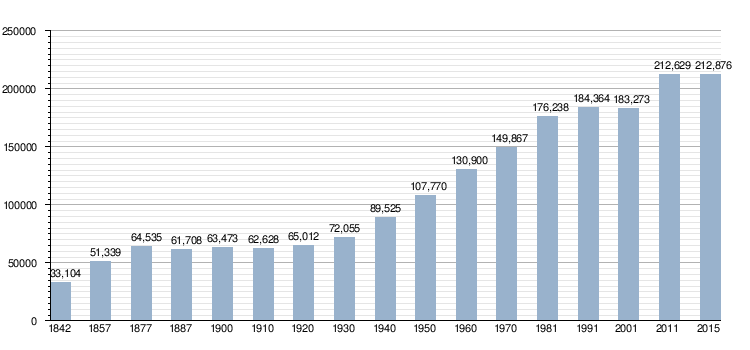Jerez de la Frontera
Jerez de la Frontera (Spanish pronunciation: [xeˈɾeθ ðe la fɾonˈteɾa]), or simply Jerez (pronounced [xeˈɾeθ]), is a Spanish city and municipality in the province of Cádiz in the autonomous community of Andalusia, in southwestern Spain, located midway between the Atlantic Ocean and the Cádiz Mountains. As of 2015, the city, the largest in the province, had a population of 212,876. It is the fifth largest in Andalusia, and has become the transportation and communications hub of the province, surpassing even Cádiz, the provincial capital, in economic activity. Jerez de la Frontera is also, in terms of land area, the largest municipality in the province, and its sprawling outlying areas are a fertile zone for agriculture. There are also many cattle ranches and horse-breeding operations, as well as a world-renowned wine industry (Xerez).
Jerez | |
|---|---|
| Jerez de la Frontera | |
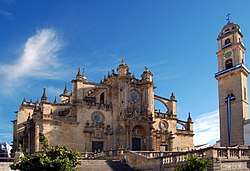 | |
 Flag  Coat of arms | |
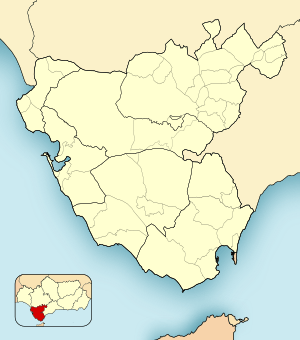 Jerez 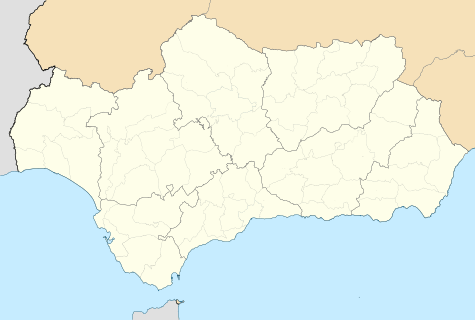 Jerez  Jerez | |
| Coordinates: 36°40′54″N 06°08′16″W | |
| Country | Spain |
| Autonomous community | Andalusia |
| Province | Cádiz |
| Comarca | Campiña de Jerez |
| Judicial district | Jerez de la Frontera |
| Municipal association | Municipios de la Bahía de Cádiz |
| Government | |
| • Mayor | Mamen Sánchez Díaz (PSOE) |
| Area | |
| • Total | 1,188.23 km2 (458.78 sq mi) |
| Elevation | 56 m (184 ft) |
| Population (2018)[1] | |
| • Total | 212,879 |
| • Rank | 25th, Spain |
| • Density | 180/km2 (460/sq mi) |
| Demonym(s) | Jerezanos |
| Time zone | UTC+1 (CET) |
| • Summer (DST) | UTC+2 (CEST) |
| Postal code | 11401 – 11409 |
| Official language(s) | Spanish |
| Website | www |
Currently, Jerez, with 212,876 inhabitants, is the 25th largest city in Spain, the 5th in Andalusia and 1st in the Province of Cádiz. It belongs to the Municipal Association of the Bay of Cádiz (Mancomunidad de Municipios Bahía de Cádiz), the 3rd largest Andalusian metropolitan area and the 12th in Spain, with over 650,000 inhabitants.
Its municipality covers an area of 1,188.14 km2 (458.74 sq mi) and includes the Los Alcornocales Natural Park and the Sierra de Gibalbín, also known as Montes de Propio de Jerez.
The city is located 12 km (7.46 mi) from the Atlantic Ocean, in Campiña de Jerez, a region suitable for cultivating the vineyards that produce famous sherry. Some famous places in the city are Alcazar of Jerez, Church of San Miguel, Charterhouse of Jerez, the Cathedral of San Salvador.
Since 1987 the Grand Prix motorcycle racing has been held at the Circuito de Jerez in early May. On this weekend, the city welcomes tens of thousands of bikers from around the world. The same circuit has hosted several Formula 1 Grands Prix, including the 1997 final race of the season, which was marred with controversy for a notable high-profile championship-deciding incident. Other popular festivals in the city are Feria de Jerez or the Holy Week in Jerez.
Jerez is known as the city of flamenco, sherry, horses and motorcycles. In 2013, Jerez was the European Capital of Wine and 2014, it was the world's first Motorbike Capital.
Etymology
The name Jerez goes back to the Phoenician Xera, Sèrès, later Romanized under the name of Ceret; the location of this settlement, however, remains unknown.
The classical Latin name of Asta Regia, unrelated to the present name, referred to an ancient city now found within Mesas de Asta, a rural district approximately 11 km (6.84 mi) from the center of Jerez.
The current Castilian name came by way of the Arabic name شريش Sherīsh.[2] In former times, during the Muslim period in Iberia, it was called Xerez or Xerés (pronounced /ʃeˈɾes̪/ in Old Spanish). The name of the famous fortified wine, sherry, which originated here (although some argue that it originated in Shiraz, Persia), represents an adaptation of the city's Arabic name, Sherish. Frontera refers to a Spanish frontier, located on the border between the Moorish and Christian regions of Spain during the 13th century, a regular host to skirmishes and clashes between the two regions. Over two centuries later, after the Castilian conquest of Granada in 1492, Xerez definitively lost its status as a frontier city, but did not lose that designation.
After the Kingdom of Castile took Jerez on October 9, 1264, following the name given by the Muslims to the city in the period known as the Reconquista, the city was then called Xerez in medieval Castilian, transcribing the consonant /ʃ/ (like the English sh) with the letter ⟨x⟩, as was the rule at the time. Thus the name was pronounced "Shereth", similar to the Moorish Arabic "Sherish". In the 16th century, the consonant /ʃ/ changed into the consonant /x/, with the corresponding spelling of Jerez.
The old spelling "Xerez" as the name given to the city survived in several foreign languages until very recently, and today continues to influence the name given to sherry: Portuguese Xerez [ʃəˈɾɛʃ], Catalan Xerès [ʃəˈɾɛs], English sherry /ˈʃɛri/, French Xérès [ɡzeʁɛs]. The city's main football team continues to use the old spelling, Xerez.
History
Prehistory and Ancient history
Traces of human presence in the area date from the upper Neolithic, and humans have inhabited Jerez de la Frontera since at least the Copper or Neolithic Age, but the identity of the first natives remains unclear. The first major protohistoric settlement in the area (around the third millennium BC) is attributed to the Tartessians.[3] Jerez later became a Roman city under the name of Asta Regia.
Middle Ages
After the fall of the Western Roman Empire, the Vandals and the Visigoths ruled it until the Arabs conquered the area in 711. In the 11th century it briefly became the seat of an independent taifa. Some years later 'Abdun ibn Muhammad united it with Arcos and ruled both (ca. 1040-1053). In 1053 it was annexed to Seville. From 1145 to 1147 the region of Arcos and Jerez briefly operated as an emirate under dependency of Granada, led by Abu'l-Qasim Ahyal. Later the Almohads conquered the city. In the 12th and 13th centuries Jerez underwent a period of great development, building its defense system and setting the current street layout of the old town.
In 1231 the Battle of Jerez took place within the town's vicinity: Christian troops under the command of Álvaro Pérez de Castro, lord of the House of Castro and grandson of Alfonso VII, king of Castile and León, defeated the troops of the Emir Ibn Hud, despite the numerical superiority of the latter. After a month-long siege in 1261, the city surrendered to Castile, but its Muslim population remained. It rebelled and was finally defeated in 1264.
Early modern period

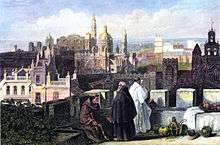
The discovery of the Americas and the conquest of Granada, in 1492, made Jerez one of the most prosperous cities of Andalusia through trade and through its proximity to the ports of Seville and Cádiz. Despite the social, economic and political decadence that occurred in the seventeenth century, towards the end of the Habsburg rule, the city managed to maintain a reasonable pace of development, becoming world-famous for its wine industry.
Late modern period
Government
Municipal government

The city of Jerez is governed by the ayuntamiento (municipality) of Jerez, whose representatives, as in other towns in Spain, are elected every four years by universal suffrage for all citizens older than 18 years of age. The body is chaired by the mayor of Jerez.
Currently, the mayor is María del Carmen Sánchez Díaz, known as Mamen Sánchez, member of Spanish Socialist Workers' Party, who won the municipal election in 2015, by the aid of Ganemos Jerez and IULV-CA.
Mayors
List of mayors of Jerez since the early twentieth century to the present:
|
|
|
Economy

The economy of Jerez has traditionally been centred on the wine industry, with exports of sherry worldwide. Because it lacks the civil service that other cities enjoy, Jerez has based its economy on industry. The cultivation of fruits, grains, and vegetables and horse and cattle husbandry has also been important to the local economy. It is the home base for the Spanish Military Stud farm, the Yeguada Militar de Jerez de la Frontera.
After the wine crisis in the 1990s, the city is now seeking to expand its industrial base. Tourism has been successfully promoted. The city's strong identity as a center for wine, flamenco, and horses, its popular festivals, MotoGP hosting and its historical heritage have contributed to this success.
The city is the home of Jerez Airport and has also been positioning itself as a logistics hub for western Andalucia, through the integration between the airport, the rail system and nearby ports.
Geography
Location
_Seville%2C_Spain_(49104522676)_(cropped).jpg)
Jerez de la Frontera is located in the region of Campiña de Jerez, which includes the municipalities of Jerez de la Frontera and San José del Valle. The territory of the region corresponds to the previous municipality of the city of Jerez, before the disintegration of San José del Valle in 1995. The municipality of Jerez is the largest in the province of Cadiz and the sixth in Spain with 1188 square kilometers, which would mean twice the island of Ibiza or half of the province of Guipúzcoa.
The region of the Campiña de Jerez is crossed by the Guadalete River. In addition, there are several wetlands in its territory, such as the lagoons of Medina and Torrox. There are also the Montes de Propio de Jerez, included in the Natural Park of Los Alcornocales. Its agriculture is famous worldwide for the designation of origin of its wine, sherry, grown in the triangle formed between Jerez de la Frontera, Sanlúcar de Barrameda and El Puerto de Santa María.
Jerez de la Frontera is located 6 km from El Puerto de Santa Maria, 12 km from the Atlantic Ocean and 85 km from the Strait of Gibraltar. The city is one of the 6 municipalities that make up the Metropolitan Area of the Bay of Cadiz-Jerez, a polynuclear urban agglomeration formed by the municipalities of Cadiz, Chiclana de la Frontera, Jerez de la Frontera, Puerto Real, El Puerto de Santa Maria and San Fernando located in the Bay of Cadiz.
Climate
Jerez de la Frontera and the rest of the Cádiz metropolitan area has a Subtropical–Mediterranean climate, yet for its situation being inland (specially the airport which is more inland than the city) the Atlantic influences are small, it is characterized by mild, short winters with occasional cool nights and hot, long summers with occasional very hot temps, unlike the surrounding coastal areas which are characterized by very mild winters and long warm summers. Most of the rain falls from October to January, while the summers are very dry but not rainless. For its situation being inland, the daytime temps are bigger than in the coast, as well as the lows are cooler, with a difference of at least 10 °C between the highs and the low temps during every month. The average annual temperature is 24.4 °C (76 °F) during the day and 11.9 °C (53 °F) at night. The average annual precipitation is 570 mm (22.4 in) per year, concentrated in the months of October through April. December is the wettest month with 109 mm (4.3 in). The city averages 53 rainy days, 137 clear days and 2,965 hours of sunshine a year. Snow is extremely rare, and it is even more infrequent than in most of the southern European islands. The last snowfall recorded in the city happened on February 2, 1954. Since then, no snowfall has been recorded.[4]
| Climate data for Jerez de la Frontera (Jerez Airport) (1981-2010), Extremes (1921-) | |||||||||||||
|---|---|---|---|---|---|---|---|---|---|---|---|---|---|
| Month | Jan | Feb | Mar | Apr | May | Jun | Jul | Aug | Sep | Oct | Nov | Dec | Year |
| Record high °C (°F) | 25.3 (77.5) |
29.0 (84.2) |
30.6 (87.1) |
33.6 (92.5) |
38.2 (100.8) |
42.0 (107.6) |
44.7 (112.5) |
45.1 (113.2) |
44.6 (112.3) |
36.5 (97.7) |
30.8 (87.4) |
26.8 (80.2) |
45.1 (113.2) |
| Average high °C (°F) | 16.2 (61.2) |
17.8 (64.0) |
20.8 (69.4) |
22.2 (72.0) |
25.5 (77.9) |
29.9 (85.8) |
33.6 (92.5) |
33.5 (92.3) |
30.4 (86.7) |
25.5 (77.9) |
20.2 (68.4) |
16.9 (62.4) |
24.4 (75.9) |
| Daily mean °C (°F) | 10.7 (51.3) |
12.1 (53.8) |
14.6 (58.3) |
16.0 (60.8) |
19.0 (66.2) |
22.9 (73.2) |
25.9 (78.6) |
26.1 (79.0) |
23.7 (74.7) |
19.6 (67.3) |
14.9 (58.8) |
12.0 (53.6) |
18.2 (64.8) |
| Average low °C (°F) | 5.2 (41.4) |
6.4 (43.5) |
8.3 (46.9) |
9.8 (49.6) |
12.5 (54.5) |
15.9 (60.6) |
18.1 (64.6) |
18.7 (65.7) |
17.0 (62.6) |
13.7 (56.7) |
9.5 (49.1) |
7.1 (44.8) |
11.9 (53.4) |
| Record low °C (°F) | −5.4 (22.3) |
−5 (23) |
−2.4 (27.7) |
−2 (28) |
5.0 (41.0) |
7.0 (44.6) |
9.8 (49.6) |
10.5 (50.9) |
7.0 (44.6) |
2.8 (37.0) |
−1 (30) |
−5.4 (22.3) |
−5.4 (22.3) |
| Average precipitation mm (inches) | 78 (3.1) |
56 (2.2) |
37 (1.5) |
49 (1.9) |
30 (1.2) |
9 (0.4) |
1 (0.0) |
2 (0.1) |
27 (1.1) |
72 (2.8) |
96 (3.8) |
109 (4.3) |
570 (22.4) |
| Average precipitation days (≥ 1 mm) | 6 | 6 | 5 | 6 | 4 | 1 | 0 | 0 | 2 | 6 | 7 | 8 | 53 |
| Average relative humidity (%) | 77 | 73 | 67 | 64 | 60 | 56 | 52 | 55 | 61 | 69 | 75 | 79 | 66 |
| Mean monthly sunshine hours | 184 | 187 | 224 | 251 | 300 | 318 | 354 | 334 | 250 | 225 | 184 | 158 | 2,965 |
| Source: Agencia Estatal de Meteorología[5][6] | |||||||||||||
Main sights
Religious sites

_20150904_101234.jpg)
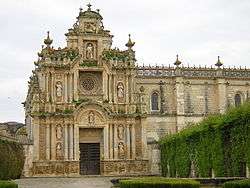
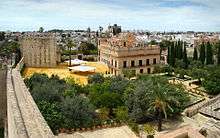
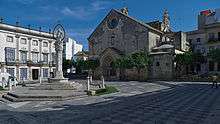
- The Cathedral
- Church of San Miguel (15th century), in Gothic–Baroque style
- Church of San Mateo, in Gothic style, the oldest in the city
- The Charterhouse
- Church of Santiago, dating to the time of Alfonso X of Castile (reigned 1252-1284)
- Church of San Juan de los Caballeros, created after Alfonso X's conquest of the city in 1264
- Church of San Marcos (13th century)
- Church of San Dionisio (13th century), built around 1457
- Church of San Lucas, built over an old mosque
- Church of San Francisco, containing the grave of Queen Blanca de Borbón (died 1361)
- Church of San Pedro
- Chapel of San Juan de Letrán
- Calvary Chapel
- Chapel of Los Desamparados
- Convent of San José
- Covent of Santa María de Gracia
- Convento of Espíritu Santo
- Hermitage of San Isidro Labrador
- Hermitage of San Telmo
- Church of Santo Domingo
- Church of Los Descalzos
- Convent of Las Reparadoras
- Church of La Victoria
- Hermitage of La Ina
- Basílica del Carmen de Jerez
Palaces and manors
- Casa-palacio de la calle Lealas, número 20
- Casa-palacio de los Ponce de León
- Casa de los Basurto
- Casa Petra de la Riva
- Palace of Marqués de Montana
- Palacio Dávila
- Palacio de Bertemati
- Palacio de Campo Real
- Palacio de Riquelme
- Palacio de los Condes de Montegil
- Palacio de los Condes de Puerto Hermoso
- Palacio de los Morla y Melgarejo
- Palacio de Luna
- Palacio de Mirabal
- Palacio de Villapanés
- Palacio de Villavicencio
- Palacio del Barón de Algar del Campo
- Palacio del Conde de los Andes
- Palacio del Marqués de Villamarta
- Palacio Duque de Abrantes
- Palacio Pemartín
- Palacio San Blas
Museums

- Archaeological Museum
- Bullfighting Museum
- Nativity scene Museum
- Museos de la Atalaya
- Pinacoteca Rivero
- Museo del Traje Andaluz
- Museo de Tecnología Agraria Antonio Cabral
- Museo del Enganche
Other monuments

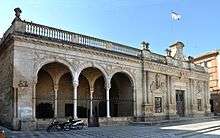
- Old City Hall of Jerez de la Frontera, built in 1575
- Alcazar of Jereze de la Frontera, a Moorish fortress, dating to the 11th century
- Zoo and Botanical Garden of Jerez.
- Villamarta Theatre
- Gallo Azul, built in 1927
- Walls of Jerez de la Frontera
Main factories
- González Byass
- Domecq
- Grupo Estévez
- Grupo Garvey
- Williams & Humbert
- Bodegas de Pilar Plá
- Bodegas Tradición
- Sánchez Romate
- Bodegas Lustau
Other infrastructure
- Crocodile Farm Kariba, unique in Spain.
- Circuit of Jerez
- Jerez Airport
- Fair Institution of Cádiz
- Chapín Stadium
- Walk of Fame Jerez de la Frontera
- Military Stud of de Jerez de la Frontera
- Jerez Bullring
- Roundabout of Minotaur
- Playground "Children's City"
- Water Tower of Jerez
- Old fish market
- Sala Compañía
- Centro Andaluz de Flamenco
- Zoco de Artesanía de Jerez
- Children's Traffic Park
Culture
Wine
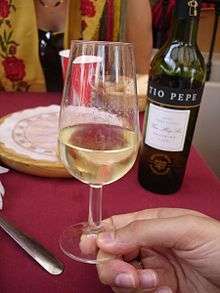
Jerez has a reputation as the world capital of sherry wine. Sherry is a fortified wine made from white grapes grown near the town of Jerez. Jerez has been a centre of viniculture since the Phoenicians winemaking to Spain in 1100 BC. The Romans continued the practice after they took control of Iberia around 200 BC. The Moors conquered the region in AD 711 and introduced distillation, which led to the development of brandy and fortified wine. Sherry became very popular in Great Britain. Because sherry was a major wine export to the United Kingdom, many English companies and styles developed. British families founded many of the Jerez cellars.
The city has many bodegas (wineries), many of which are of British origin. The most important include:
- González Byass: González Byass is one of Spain's most well-known sherry bodegas. Manuel María González Angel founded it in 1835, and his English agent, Robert Blake Byass subsequently joined in. The firm produces the fino sherry Tío Pepe. According to the Guinness World Records, the world's largest weather vane is located in Gonzalez Byass winery in Jerez, Spain.
- Williams & Humbert: This is a winery located in Jerez de la Frontera dedicated to the production of sherry wines and brandies and other liqueurs. Sir Alexander Williams and Arthur Humbert founded it in 1877.
- Grupo Garvey: William Garvey Power founded Grupo Garvey in 1780. As of 2018 it is considered one of the most important companies for wine, brandy and liqueurs.
- Grupo Estévez: Estevez Group owns the prestigious wineries Marqués del Real Tesoro and Valdespino, one of the oldest in the area (with origins dating from 1430).
- Domecq: Domecq is a winemaking company founded by Álvaro Domecq Díez's father. It is located in Jerez de la Frontera.
Brandy de Jerez is a brandy produced only in the Jerez area of Andalusia, Spain (exclusively produced within the "Sherry Triangle", the municipal boundaries of Jerez de la Frontera, El Puerto de Santa María and Sanlúcar de Barrameda, in the province of Cádiz).
"Enoturism" is a quite new kind of tourism that looks for places where wines and distilled beverages are produced. Recently the Route of Sherry Wine and Brandy de Jerez has been established.
Brandy de Jerez is being used in Spanish cuisine in recent years, especially with meats.
Carthusian breed of horses

Jerez is the original home of the Carthusian sub-strain of the Andalusian horse breed, known as the Caballo cartujano in Spain. In the latter 1400s, the Carthusian monks began breeding horses on lands donated by Álvaro Obertos de Valeto for construction of the Charterhouse of Jerez de la Frontera (la Cartuja de Jerez de la Frontera). When the Spanish Crown decreed that Spanish horse breeders should breed their Andalusian stock with Neapolitan and central European stock, the monks refused to comply,[8] and continued to select their best specimens to develop their own jealously guarded bloodline for almost four hundred years.
Jerez is the home of the Royal Andalusian School of Equestrian Art, a riding school comparable to the famous Spanish Riding School of Vienna.
Another famous equine institution headquartered in Jerez is the Yeguada Militar de Jerez de la Frontera (known outside Spain as the Yeguada Militar), the Spanish military stud farm dedicated to the breeding of purebred Andalusian and Arabian horses. Founded in 1847, it became the official stud farm of the Spanish military in 1893.
The 2002 FEI World Equestrian Games were held in Jerez at the Estadio Municipal de Chapín, which was remodeled for the event, from September 10 to September 22, 2002. This was the 4th edition of the games, which are held every four years and run by the FEI.
Flamenco
Jerez, the city where flamenco singing began, is also proud of its Andalusian Centre of Flamenco. It was founded in 1993 to safeguard and promote the values and standards of flamenco. It is devoted to the investigation, recovery, and collection of flamenco-related historical documents, whether they are in audio, visual, or journalistic form. It also has a collection of flamenco artifacts, including musical instruments, costumes, promotional posters, sheet music, and postcards. The centre operates a museum and library to help educate the public and serve as a resource for scholars. Its origins date back to the 18th century and it is currently considered an intangible cultural heritage by UNESCO. Many of the most famous personalities of the city are involved in the performance of flamenco, including La Paquera de Jerez, Lola Flores and José Mercé.
Festivals
Since 1987 the Grand Prix motorcycle racing has been held at the Circuito de Jerez in early May. Thousands of motorbikers from around the world come to the city this week to watch the MotoGP race held in Jerez annually. The race is one of the most watched races in Europe.
Another popular festival is the Feria del Caballo, one of the most famous Spanish fairs, and the most important fair in the province of Cádiz. It is celebrated annually in the Parque González Hontoria for one week in May, occurring always after the Spanish motorcycle Grand Prix. All booths (casetas) at the fair are open to the public, so that attendees may walk into any one of them and enjoy the food, drinks, and dancing. This is one of the main features that differentiates the Feria de Jerez from the rest of the Andalusian Fairs, such as the Seville Fair, where most of the casetas are private and only card-holding members are allowed in.
Holy Week in Jerez, as in other cities in Andalusia, commemorates the Passion of Jesus Christ. It is celebrated by Catholic religious brotherhoods and fraternities that perform penance processions on the streets during the last week of Lent, the week immediately before Easter.
During the Christmas season, from the end of November to the end of December, many peñas (religious clubs) celebrate the holidays with public festivals where anyone can go to drink, eat, dance and sing Christmas carols, accompanied by friction drums called zambombas.
There are also:
- Flamenco festival de Jerez
- Carnival of Jerez
- Fiestas de la Vendimia
Other institutions
The old quarter of Jerez, dating from medieval times, has been named an "Artistic Historic Complex". The Easter week celebrations in Jerez are of "National Touristic Interest", and its remarkable Horse Fair (Feria del Caballo) in May is an event of "International Touristic Interest".
The Andalusian Flamenco Centre is located in the Pemartín Palace (Palacio de Pemartin) and offers a library, displays, video films and live demonstrations of the art of flamenco dancing.
Sport
Circuito de Jerez

The city of Jerez is the first motorcycling world capital.[9] It is the site of Circuito de Jerez, formerly called the Circuito Permanente de Jerez, where the annual MotoGP Motorcycle Grand Prix is contested.
The race course is also a prime destination for Formula One teams wishing to perform off-season testing. In the past it has hosted the F1 race itself, namely the Spanish Grand Prix between 1986 and 1990, before the race moved permanently to the Catalunya Circuit near Barcelona. Since then Jerez hosted the Formula One races a few times, with the designation of the European Grand Prix in 1994 and the controversial race in 1997.
Complejo Municipal de Chapín
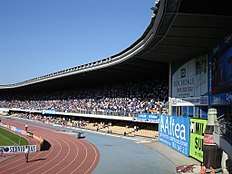
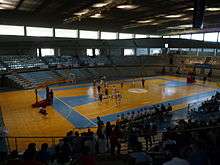
The Complejo Municipal de Chapín is a complex of sports facilities that includes a football stadium and field, a baseball field, equestrian facilities and a Sports Hall, as well as a futsal field and basketball and volleyball courts.
The Estadio Municipal de Chapín, a multi-purpose stadium, was built in 1988 and seats 20,523 spectators. In 2002 the stadium was remodeled to hold the 2002 FEI World Equestrian Games. The whole grandstand was covered with a roof, and a hotel and spa-gym were added. It was historically the home of Xerez CD, the city's club founded in 1947 and known simply as Xerez, which played in the top division in the 2009–2010 season. Currently, the stadium is the home of Xerez Deportivo FC, founded in 2013 to replace the old Xerez club.
The stadium, which has a running track, was designated as an Olympic Stadium. The most important track team training there is the Club Atletismo Xerez Deportivo FC, which won the Spanish championships in 2001–2007..
Canasta Unibasket Jerez and DKV Jerez are the city's basketball teams; they play in Palacio Municipal de Deportes de Chapín.
Venenciadores de Jerez, the city's baseball team, is currently without a home field and awaits completion of one in the Complejo Municipal de Chapín.
The main futsal team in Jerez is Xerez Deportivo FC (also known as Xerez Toyota Nimauto for sponsorship reasons). It was founded in 2014 and currently plays in the Ruiz Mateos Sports Center and the Palacio Municipal de Deportes de Chapín in Segunda Andaluza.
The most important rugby club is Club Rugby Xerez, which trains at the Pradera Hípica in Chapín.
Domecq Stadium
The Domecq Stadium was the first football stadium in Jerez de la Frontera. It was the home of Xerez CD and Jerez Industrial CF before its demolition. The Stadium del Parque (Park Stadium) was built in 1923 and remodeled (with the name of Domecq Stadium) in 1932 by the architect Francisco Hernández Rubio. It held 20,523 and it was demolished in 1988.
Juventud Stadium

Currently, the Juventud Stadium is the oldest stadium in the city. It holds 5,000 and is the home of Jerez Industrial CF, founded in 1951, the main rival of Xerez.
Formerly, the football field belonged to the youth hostel which is located in the vicinity thereof, hence its name.
Antonio Fernández Marchán Stadium
It is the CD Guadalcacín stadium, which plays in the Tercera Division. It is placed in Guadalcacín, a neighborhood northern Jerez.
Other sports complexes
- Complejo Deportivo de La Granja
- Campo de fútbol de La Canaleja
- Campo de Fútbol Manuel Millán
- Campo de fútbol Juan Fernández Simón
- Campo de fútbol de Picadueña
- Polideportivo Ruiz-Mateos
Other sports
The 2014 Vuelta a España cycle race began in Jerez de la Frontera on 23 August, with a 12.6 km (7.8 mi) team time trial. The race followed a 21-stage route, finishing in Santiago de Compostela on 14 September.
Club Natación Jerez, is the main Swimming Club in Jerez. It has won the "Campeonato de España Master" ("Championship of Spain Master") many times.
Education
There are 76 elementary schools, 41 secondary schools, 12 adult education centres and 10 public libraries in the city of Jerez.
University of Cádiz
The University of Cádiz, the provincial university, has a campus in Jerez. It specializes in socio-political studies.
The city is also home to a member of the Official School of Languages (Escuela Oficial de Idiomas) and a centre of the National Distance Education University (Universidad Nacional de Educación a Distancia, UNED).
Transportation
Airport
El Aeropuerto de Jerez, also known as Aeropuerto de La Parra, is the main airport in the province of Cádiz. It is located 8 km (5 mi) north of the city centre and is connected to the city by train and bus.
It was built in 1937, during the Spanish Civil War by the Nationalists in order to transport soldiers from Africa to Spain. The airport was open to civil traffic in 1992. It is the third most important airport in Andalucia after Malaga and Seville.
Train
Jerez has had a railway line since 1854, which was one of the first in Spain, the Alcázar de San Juan–Cádiz railway. The line went between Jerez and El Puerto de Santa María and transported wine barrels for export. Jerez de la Frontera railway station is used by more passengers than Cádiz and is the fourth busiest in Andalucia.
Next to the Aeropuerto de Jerez, there is a new train station which connects the airport through the Cercanías Cádiz line C-1 to nearby Jerez, and also to Cádiz, Sevilla, Lebrija, Utrera, El Puerto de Santa María, and San Fernando.
Bus
The city of Jerez has 16 bus lines:
- L 1 Esteve-San Telmo-Constitución
- L 2 Esteve-Picadueñas
- L 3 Esteve-La Plata-Mosto-San Juan de Dios
- L 4 Esteve-García Lorca-El Altillo
- L 5 Esteve-Campus-Guadalcacín
- L 6 Esteve-Campus-La Granja
- L 7 Angustias-La Pita-Estella del Marqués
- L 8 Circunvalación I
- L 9 Circunvalación II
- L 10 Canaleja-Atlántico-Esteve-Hacienda-Hospital
- L 12 Alcázar-C. Salud San Telmo-El Portal/Guadabajaque
- L 13 Alcázar-Blas Infante-Asisa
- L 14 Esteve-Villas Este-La Marquesa
- L 16 Casinos-Hipercor-Ortega Y Gasset
- L 19 Nueva Jarilla-Guadalcacín-Angustias
- L 20 Rotonda-García Lorca-Guadalcacín
Intercity buses
From Jerez are made regular trips to the following towns:
Roads
| Identificador | Itinerario | Observaciones |
|---|---|---|
| A-4 E-5 | Madrid - Córdoba - Seville - Dos Hermanas - Jerez - El Puerto de Santa María - Puerto Real - Cádiz | Connects Jerez and the Province of Cádiz to Province of Seville |
| AP-4 E-5 | Seville - Jerez - Cádiz | Connects Jerez and the Province of Cádiz to Province of Seville |
| A-381 | Jerez - Medina Sidonia - Alcalá de los Gazules - Los Barrios | Connects Jerez to the Janda and the Campo de Gibraltar |
| A-382 | Jerez - Jédula - Arcos de la Frontera | Connects Jerez to the Sierra de Cádiz |
| A-480 | Chipiona - Sanlúcar de Barrameda - Jerez | Connects Bajo Guadalquivir to Jerez |
Bicycle
Jerez has 41 km (25 mi) of bike lanes that follow the main avenues of the city.
Demographics
According to official population data from INE, the municipality of Jerez had 212,876[10] inhabitants as of January 1, 2015. This makes Jerez the most populous city in the province, fifth in Andalusia, and 25th in Spain.
Population distribution
| Population centre names | Kind | Population 2012 | Distance from city centre |
|---|---|---|---|
| Cuartillos | Rural neighbourhood | 1,300 inhabitants | 11 km east |
| El Mojo-Baldío de Gallardo | Rural neighbourhood | 400 inhabitants | 16 km southeast |
| El Portal | Rural neighbourhood | 700 inhabitants | 6 km south |
| Estella del Marqués | Village | 1,650 inhabitants | 5,5 km east |
| El Torno | Village | 1,300 inhabitants | 20 km east |
| Gibalbín | Rural neighbourhood | 550 inhabitants | 30 km northeast |
| Guadalcacín | Village | 5,500 inhabitants | 5 km northeast |
| Jerez de la Frontera (city) | City | 190,000 inhabitants | |
| La Barca de la Florida | Village | 4,353 inhabitants | 20 km east |
| La Corta | Rural neighbourhood | 550 inhabitants | 3,8 km south |
| La Ina | Rural neighbourhood | 800 inhabitants | 10 km southeast |
| Las Pachecas | Rural neighbourhood | 430 inhabitants | 8 km southeast |
| Las Tablas, Polila y Añina | Rural neighbourhood | 400 inhabitants | 6 km west |
| Lomopardo | Rural neighbourhood | 283 inhabitants | 5 km southeast |
| Los Albarizones | Rural neighbourhood | 420 inhabitants | 3,5 km southeast |
| Majarromaque | Rural neighbourhood | 500 inhabitants | 26 km east |
| Mesas de Asta | Rural neighbourhood | 600 inhabitants | 11 km east |
| Mesas de Santa Rosa | Rural neighbourhood | 300 inhabitants | 5 km north |
| Nueva Jarilla | Village | 1,600 inhabitants | 15 km northeast |
| Puente de la Guareña | Rural neighbourhood | 500 inhabitants | 16 km east |
| Rajamancera | Rural neighbourhood | 485 inhabitants | 8 km southeast |
| San Isidro del Guadalete | Village | 650 inhabitants | 15 km southeast |
| Torrecera | Village | 1,280 inhabitants | 20 km southeast |
| Torremelgarejo | Rural neighbourhood | 730 inhabitants | 10 km east |
Immigration
| Non-EU Countries | ||||||
| AFRICA | ||||||
| AMERICAS | ||||||
| ASIA | ||||||
| OTHERS | ||||||
| TOTAL | ||||||
People

- Manuel Alejandro
- Mercedes Chilla
- Daniel Güiza
- Kiko
- Lola Flores
- José Mercé
- Álvar Núñez Cabeza de Vaca
- Gerardo Núñez
- Juan José Palomino Jiménez
- Miguel Primo de Rivera
- Mala Rodriguez
- Luis Coloma, creator of Ratoncito Pérez
- José Manuel Caballero Bonald
- Juan José Padilla
- Rafael de Paula
- Pilar Paz Pasamar
- Marina Garcia Herrera
International relations
Twin towns – Sister cities
Jerez de la Frontera is twinned with:












References
- Municipal Register of Spain 2018. National Statistics Institute.
- Deroy Louis, & Mulon Marianne (1992) Dictionnaire des noms de lieux, París: Le Robert
- Pedro Bosch Gimpera (1995). El poblamiento antiguo y la formación de los pueblos de España. UNAM. p. 210. ISBN 978-968-36-4439-8.
- Velo, Eduardo (2 February 2018). "La última vez que nevó en Jerez - Mira Jerez". mirajerez.com. Archived from the original on 2018-02-16. Retrieved 18 March 2018.
- "Guía resumida del clima en España (1981-2010)". Archived from the original on 2013-05-26.
- Meteorología, Agencia Estatal de. "Jerez de la Frontera Aeropuerto: Jerez de la Frontera Aeropuerto - Valores extremos absolutos - Selector - Agencia Estatal de Meteorología - AEMET. Gobierno de España". www.aemet.es. Retrieved 18 March 2018.
- Johnson, Carla; Leatherman, Alyson (2005). "El Toro de Osborne: advertising, community, and myth". The Social Science Journal. 42: 135–140. doi:10.1016/j.soscij.2004.11.012.
- Bonnie L. Hendricks (2007). International Encyclopedia of Horse Breeds. University of Oklahoma Press. p. 111. ISBN 978-0-8061-3884-8.
- http://www.circuitodejerez.com/index.php?id=29&no_cache=1&tx_ttnews%5BbackPid%5D=126&tx_ttnews%5Btt_news%5D=487&cHash=842ea3c1aaec9e93bd683d28958ca24b JEREZ SERÁ CAPITAL MUNDIAL DEL MOTOCICLISMO EN 2015
- "Population figures since 1996". ine.es. Spain's National Institute of Statistics. Archived from the original on 2009-07-03. Retrieved 18 March 2018.
- INEbase. Variaciones intercensales. En línea: http://www.ine.es/intercensal/ Consultado 10-07-2011. Cuando se dispone del dato de población de hecho y de derecho se ha tomado la cifra más alta.
- "Población en Jerez de la Frontera, según procedencia" (PDF). jerez.es. Retrieved 18 March 2018.
- "Hermanamientos". Ayuntamiento de Jerez de la Frontera. Archived from the original on 2019-03-03.
- "Twin towns, Biarritz official website". Biarritz.fr. Archived from the original on 2013-07-29. Retrieved 2013-05-11.
- "Mayor's Newsletter". www.elpasotexas.gov. Archived from the original on 2012-02-13. Retrieved 2012-02-17.
Bibliography
External links


- Jerez de la Frontera at Curlie (in Spanish)
- Jerez de la Frontera airport
- Jerez News, social digital newspaper
- Jerez eGuide
- Jerez.TV, tourism and videos from Jerez de la Frontera
- City guide for Jerez
- Andalucia Events
- Jerez from Seville
